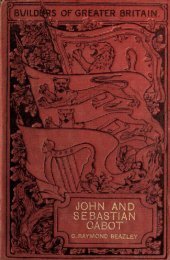st. john of damascus (676-749 - Cristo Raul
st. john of damascus (676-749 - Cristo Raul
st. john of damascus (676-749 - Cristo Raul
Create successful ePaper yourself
Turn your PDF publications into a flip-book with our unique Google optimized e-Paper software.
:<br />
"<br />
"<br />
"<br />
"<br />
"<br />
"<br />
"<br />
"<br />
"<br />
v<br />
70 ST. JOHN OF DAMASCUS.<br />
The third and longe<strong>st</strong> <strong>of</strong> the series, the De Fide<br />
Orthodoxa," is<br />
perhaps the mo<strong>st</strong> important <strong>of</strong> all<br />
John s writings, and, in some respects one <strong>of</strong> the<br />
mo<strong>st</strong> important works that have come down to us<br />
from Chri<strong>st</strong>ian antiquity. For it is the fir<strong>st</strong><br />
complete<br />
Body <strong>of</strong> Divinity that we possess, and, as such,<br />
has had an influence that cannot easily be measured<br />
r on the theology <strong>of</strong> the We<strong>st</strong>. It was made known to<br />
7<br />
the Latin Church by the version <strong>of</strong> Burgundio <strong>of</strong><br />
Pisa. John <strong>of</strong> Brompton fixes the date with pre<br />
cision, by saying that the translation was made the<br />
same year that the Thames was frozen over/, e.,<br />
"Vin<br />
the Great Fro<strong>st</strong> <strong>of</strong> uso. 1 The <strong>st</strong>atement that<br />
Peter Lombard had this version before him when<br />
preparing his Book <strong>of</strong> the Sentences thus becomes<br />
quite probable. Without, therefore, taking account<br />
<strong>of</strong> Aquinas, later on, whose indebtedness to the work<br />
<strong>of</strong> Damascenus is admittedly great, we have here<br />
v a visible link <strong>of</strong> connection between the Ea<strong>st</strong>ern<br />
Church and the We<strong>st</strong>ern. In fact, the common<br />
division into four books, which the De Fide pre<br />
sents, is thought, not without good reason, to have<br />
been the work <strong>of</strong> transcribers seeking to make it<br />
harmonise more closely, even in outward form, with<br />
the popular textbook <strong>of</strong> Lombardus. The division<br />
into four books seems to have been a favourite one<br />
Hi<strong>st</strong>oire Generale (1752), torn, xviii., p. 117, seems to draw<br />
an inference from the equivalence <strong>of</strong> the Latin words by which<br />
these two are rendered, and which he quotes<br />
: "Nous devons<br />
adorer et honorer (car il met ces deux termescomme synonymes)<br />
la tres-sainte Mere de Dieu."<br />
1<br />
Twysden s "Decem Scriptores," p. 1036.
















